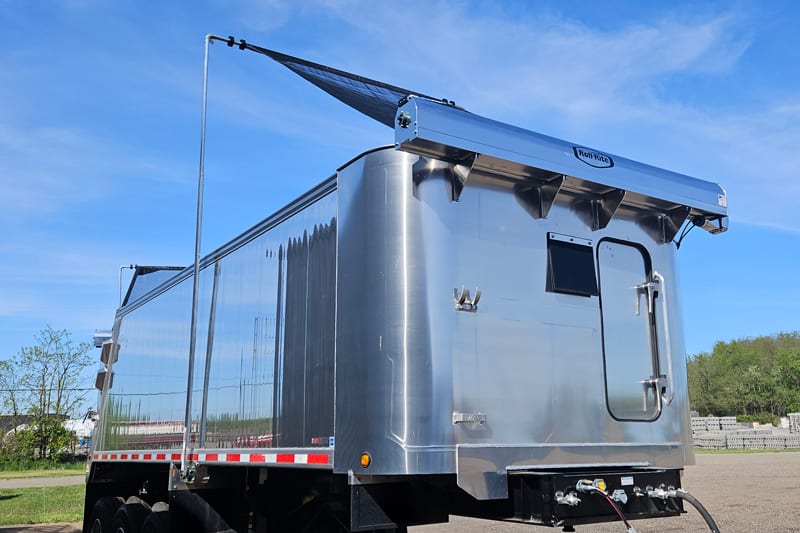
Automated tarp systems are essential for hauling operations, offering a reliable and efficient way to secure loads on trailers, including end dumps, belly dumps, and transfer trailers. These trailers are commonly used across the construction, agriculture, and waste management industries, where load containment is critical to safety, regulatory compliance, and overall efficiency.
An automated tarp system is a smart choice to increase productivity with fast covering and uncovering of loads, reduce the time and labor involved, and increase driver safety. Choosing the right system for your trailer can make a significant difference in daily operations. These systems protect materials from the elements and prevent loose debris from spilling onto the road.
In this article, we’ll explore the key features of trailer tarps, the benefits of using automated systems, and recommendations on selecting the best model for your specific trailer needs.
Automated Flip Tarp Systems for Trailers
Flip tarp systems are a type of front-to-back tarp system designed to cover and uncover a load quickly. They include a high-torque electric motor that pivots steel or aluminum arms over the trailer. A series of springs and pivot pins work to carefully unroll the tarp from the housing unit, which can be mounted in different locations depending on the trailer. The best systems include a quality motor along with durable arm construction.
Why Choose Automated Tarp Systems for Trailers?
In heavy-duty hauling scenarios, automated tarp systems are preferred over manual roll tarp systems because they save time and increase efficiency while promoting safety. Drivers can handle more loads in a day, ensuring a quicker return on investment—the ability to haul even one extra load per day can translate into significant additional revenue, which could be realized within weeks.
These systems also enhance driver safety by lowering the risk of injury, allowing drivers to remain in the cab or operate the system from a safe distance outside the truck. Haulers have experienced additional cost savings with some insurance carriers that classify automated tarp systems as a safety feature.
Most states require trucks to be covered so that no materials can escape. But the needs of each hauler are different depending on the trailer application – as we’ve emphasized before, there is no one-size-fits-all solution. Different materials require specific types of tarps, and different trailers have unique needs, so it’s imperative to do your research and select the right system.
Trailer Tarps: Selecting the Right Size and Type
Choosing the correct tarp size and type for your trailer is essential for maintaining secure, efficient, and compliant hauling operations. Selecting the right tarp involves considering factors such as load type, trailer dimensions, and the specific demands of each hauling application.
Trailer Tarps for Construction
Dump trailers in the construction industry haul debris such as asphalt, crushed materials, dirt, gravel, junk, refuse, sand, and stone. This industry typically leverages end dump trailers because they can hold a large volume and quickly dump the load. End dump trailers are commonly paired with flip-style tarp systems, but they are also compatible with power cable tarp systems and side lock-down tarp systems.
Trailer Tarps for Agriculture
Agricultural trailers are used to transport a variety of loads, ranging from grain, produce, soil, silage, and more. Grain trailers are specialized trailers designed for transporting moisture-sensitive grains in bulk, such as wheat or corn. Grain trailers cover loads with a vinyl roll tarp, such as an automated side-to-side lock-down system. Flip tarps or arm-style tarp systems are widely used for dump and silage trailers in agriculture.
Trailer Tarps for Refuse and Recycling
Dump trailers can also handle heavy loads associated with the waste management and recycling industries. They are designed to maximize loading capacity and make unloading easier. They also have unique demands that require a durable load securement solution. Flip tarps or arm-style tarp systems are widely used in this industry. Some transfer trailers and side dump trailers require secure load coverage, and professionals opt for side lock-down or side roll tarp systems.
Correctly Sizing Your Trailer Tarp
Determining the correct tarp size is equally important as outlining how it will be used. The tarp should fully cover the trailer bed and extend slightly beyond the edges to ensure a snug, secure fit. Measurements based on trailer dimensions and load height allow for effective containment, reducing the risk of material spillage during transit. The length of the tarp is key for a proper fit. Flip-style tarp systems require a tarp a few feet longer than your trailer so it can be properly secured within the housing unit.
How to Choose the Right Model Based on Your Trailer’s Needs
One of the industry’s most widely used arm-style systems is Roll·Rite’s TarpMaster® Series. This system is designed to fit most industry standard end dump, belly dump, and pup trailers with up to a 34-foot body. The systems are pre-packaged with pre-assembled components for easy installation.
Given that trailer bodies come in many sizes, selecting the right tarping system with the features and functions that meet your trailer needs ensures your tarp system will operate efficiently. In the case of the TarpMaster® Series for Trailers, Roll-Rite offers a TM5000 and a TM6000. The two models feature different mounting options – external mount or underbody mount. They also offer five or six tension springs, which correspond to tarp length.
The type of tarp you use will impact tension spring capacity, so be sure to factor that in as well. There are three main classifications of tarp materials:
-
Mesh: An industry standard tarp material designed for general tarping purposes.
-
Vinyl: Best for more heat or moisture-sensitive loads.
-
Asphalt: As the name suggests, suitable for hauling temperature-sensitive asphalt
The proper tarp for your hauling needs can mean the difference between a successfully delivered load or a major liability, so be sure to explore all your options and contact the manufacturer with any questions.
Remember to shop with a reputable manufacturer that provides the resources to help you find the ideal tarping solution for your needs. While these tarping systems are designed to operate in harsh environments, regular inspection and maintenance are part of ownership. Owner-operators, fleet companies, and municipalities should consider manufacturers that make it easy to source original factory replacement parts and components.
Tarps for Trailers: Next Steps for Haulers and Operators
Whether you’re hauling heavy loads in an end dump or managing frequent runs with a pup trailer, finding the right tarp for your trailer is essential to maximizing performance and protecting your load. Businesses and operators will benefit greatly when they install the right system, ultimately saving valuable time and creating a safer environment.
Consultations for tarp and safety upfit solutions are available through Roll·Rite's Safe Fleet Service Centers in several key U.S. regions from coast to coast. You may contact our experts directly for quotes, product information, or for help finding your authorized distributor.
ABOUT THE AUTHOR
Gary Viall
Senior National Sales Manager, Trailers
Gary Viall has over 26 years of sales experience and is an expert in covering solutions for trailers.

 English
English  Français
Français  Deutsch
Deutsch  Nederlands
Nederlands  Français
Français  English
English  English
English 

